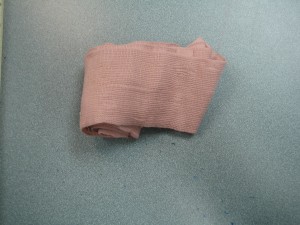Being prepared in delivering first aid measures is definitely an advantage. One of the first aid skills that you should be familiar with is how to apply a bandage. It is important to note that there are key points to bear in mind in bandage application.
- Ensure that the individual is comfortable and inform him/her what you are doing
- Make sure that you will work on the side of the injury without the need to lean across the body
- Always keep the injured body part properly supported in a position it will be when the bandage is on.
- Ensure that the bandage used has the right size. Remember that various parts of the body require different widths.
- If possible, do not cover toes or finger when a limb is being bandaged so that you can readily check the circulation.
- Apply the bandage in a firm manner, but not too tight and secure the end by folding it over and tying a knot in the end. You can also utilize a safety pin, bandage clip or adhesive tape.

Apply the bandage in a firm manner, but not too tight and secure the end by folding it over and tying a knot in the end. You can also utilize a safety pin, bandage clip or adhesive tape. - Once the bandage is one, ask the individual if it is too tight and check the circulation by pressing on the skin or fingernail until it turns pale. If the color does not return right away, the bandage is too tight, thus you have to slacken it a bit. The limbs can swell right after an injury, thus you have to check the circulation every 10 minutes after the application.
Types of bandage
There are 3 main types of bandages that you should be familiar with – tubular, roller and triangular.
Tubular bandages
These are used to hold dressings on toes or fingers or provide support to injured joints. Tubular bandages are made out of seamless fabric tube. There are also elasticized varieties that are placed over joints such as the ankle. The ones that are made out of tubular gauze can be placed over toes or fingers but could not provide pressure to control bleeding.
Before applying a tubular wrap over the injury, you have to cut it to a smaller size. Some bandages have a specialized device that is applied over the injured area to help with the application of the bandage.
Roller bandages
Roller bandages are available in 3 types.
- Those made out of open-weave material to allow ventilation but does not place pressure on the wounds and could not support the joints
- Elasticized bandages that mold to the body shape are used to secure dressings as well as support soft tissue injuries
- Crepe bandages are utilized to provide sturdy support to injured joints
When a roller type is applied, keep the rolled part above the injury and the unrolled part below. Start by wrapping twice around the injured area to hold the end in place. Work up the limb by winding the bandage in spiral turns to ensure that every layer covers one-third to two-thirds of the previous layers. Finish by wrapping the bandage around another time and securing the end.
Triangular bandages
The triangular bandages can be utilized as large dressings such as slings to support a limb or to secure a dressing in place.
When this type is used to provide support to a lower limb or large-sized dressing, it should be folded in half in a horizontal manner so the pointed edge of the triangle is in contact with the center of the long edge. It should be folded in half again in the same direction to create a broad strip.

